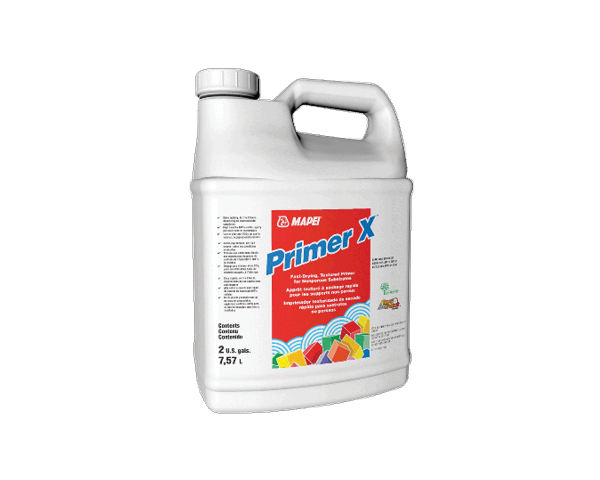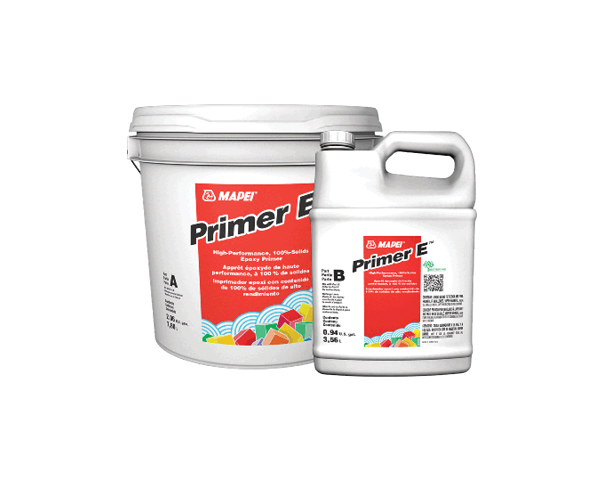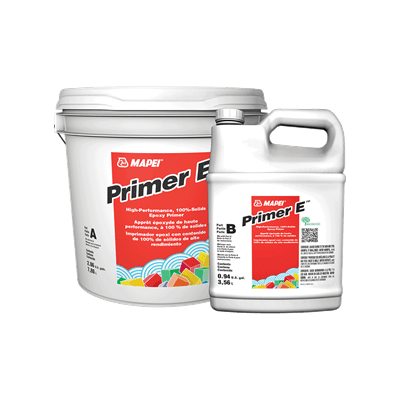 When it comes to surface preparations or floor installations, MAPEI offers some advanced primers that extend a little beyond those used for standard plywood or concrete surfaces. Whenever the floor construction, bond strength requirements, or substrate material is something out of the ordinary, it’s a good idea to use an advanced primer for the job.
When it comes to surface preparations or floor installations, MAPEI offers some advanced primers that extend a little beyond those used for standard plywood or concrete surfaces. Whenever the floor construction, bond strength requirements, or substrate material is something out of the ordinary, it’s a good idea to use an advanced primer for the job.
 Primer X is the newest low-VOC water-based acrylic primer for self-leveling underlayments added to our lineup. It’s easy to use and fast-drying and can be used everywhere that Primer T can, but is designed to dry in as little as one hour over non-porous substrates compared to up to five hours for Primer T. Primer X is a single coat, ¼" (6.4 mm) nap roller application, so the coverage rate is an impressive 1,200 to 1,400 sq. ft. (111.5 to 130 m²) per 2 U.S. gals. (7.57L) jug! You’ll notice the product is gritted, which offers even more for self-leveling underlayment to grab onto. It is also capable of going over such smooth surfaces as epoxy terrazzo, poured epoxy flooring, and MAPEI’s epoxy moisture barriers.
Primer X is the newest low-VOC water-based acrylic primer for self-leveling underlayments added to our lineup. It’s easy to use and fast-drying and can be used everywhere that Primer T can, but is designed to dry in as little as one hour over non-porous substrates compared to up to five hours for Primer T. Primer X is a single coat, ¼" (6.4 mm) nap roller application, so the coverage rate is an impressive 1,200 to 1,400 sq. ft. (111.5 to 130 m²) per 2 U.S. gals. (7.57L) jug! You’ll notice the product is gritted, which offers even more for self-leveling underlayment to grab onto. It is also capable of going over such smooth surfaces as epoxy terrazzo, poured epoxy flooring, and MAPEI’s epoxy moisture barriers.
Steel and other metallic substrates are not common surfaces that an installer will be faced with, but the situation does comes up on occasion, such as with floor covering for the marine and maritime industries, for example. The recommended priming system over metal and other similarly challenging substrates is to use an epoxy sand-broadcast product.
 I definitely encourage you to contact your nearest MAPEI technical services or sales representative to ensure that you select the right MAPEI epoxy primer/bonding agent, and pair it with an appropriate selection of sand. Such MAPEI products as Primer E and Planibond EBA are the primer/bonding agents involved in this system. The process is basically to mix and then spread the epoxy over the substrate with the appropriate notched spreader.
I definitely encourage you to contact your nearest MAPEI technical services or sales representative to ensure that you select the right MAPEI epoxy primer/bonding agent, and pair it with an appropriate selection of sand. Such MAPEI products as Primer E and Planibond EBA are the primer/bonding agents involved in this system. The process is basically to mix and then spread the epoxy over the substrate with the appropriate notched spreader.
Immediately after spreading, back-roll (i.e. flatten the notches into a consistent flat layer) using a short nap cage roller.
Next, sand is broadcasted (or tossed) liberally onto the epoxy while it is still wet, until the entire floor is covered, with no wet sand visible. It is critical to make sure that there are no areas where the sand is allowed to sink into the epoxy, as this will leave behind a smooth spot the self-leveler will not bond to. Once the epoxy has cured, vacuum up all unbonded sand from the surface. The prepared surface will look something like sandpaper at this point. It is important to ensure no loose layer of sand is left behind after vacuuming is completed. A surface that is prepared properly using this method will have a tremendous bond to the substrate, allowing for self-leveling concrete toppings such as Ultratop [NA] , Ultratop SP and Ultratop PC to be used on exposed wear surfaces.
 The last primer I will mention in this series is another epoxy primer. If you are faced with installing over a sometimes problematic and weak substrate that is structurally sound but powdery, soft, or constantly dusting off from its surface, it might be possible to remediate it. Certainly contact your MAPEI representative if this situation arises, and ask about Primer CE. The “CE” in its name stands for consolidating epoxy. This is an especially low viscosity product that is readily absorbed by porous substrates. Spread Primer CE over the surface and maintain a wet film on the surface for at least 15 minutes. The product will sink into the top 1/16" to 1/4" (1.6 to 6.4 mm) of materials such as concrete, lightweight concrete, and poured gypsum floor underlayment. Once the absorbed Primer CE is cured, it binds the weak elements of the surface into a more solid layer that can support a flooring installation. After five to six hours, Primer X or any of the MAPEI epoxy sand-broadcast primers can be used to prepare for a self-leveling underlayment, such as a self-leveling compound or a self-leveling cement product. Loose lay flooring products and floors bonded by select non-water based adhesives can be installed directly over Primer CE.
The last primer I will mention in this series is another epoxy primer. If you are faced with installing over a sometimes problematic and weak substrate that is structurally sound but powdery, soft, or constantly dusting off from its surface, it might be possible to remediate it. Certainly contact your MAPEI representative if this situation arises, and ask about Primer CE. The “CE” in its name stands for consolidating epoxy. This is an especially low viscosity product that is readily absorbed by porous substrates. Spread Primer CE over the surface and maintain a wet film on the surface for at least 15 minutes. The product will sink into the top 1/16" to 1/4" (1.6 to 6.4 mm) of materials such as concrete, lightweight concrete, and poured gypsum floor underlayment. Once the absorbed Primer CE is cured, it binds the weak elements of the surface into a more solid layer that can support a flooring installation. After five to six hours, Primer X or any of the MAPEI epoxy sand-broadcast primers can be used to prepare for a self-leveling underlayment, such as a self-leveling compound or a self-leveling cement product. Loose lay flooring products and floors bonded by select non-water based adhesives can be installed directly over Primer CE.
I hope this information proves useful to you in future floor preparation scenarios, such as those for self-leveling underlayments. It’s worth adding an extra detail of note: always check the product data sheets prior to applying these products for up-to-date instructions. The epoxy products generally require extra consideration before use, so be sure to consult their technical and safety data sheets using the links below, for instructions including the use of personal protective equipment.







Toll-free within Canada:
Technical Services at 1-800-361-9309
Customer Service at 1-800-668-1212
Copyright © 2025 MAPEI Inc. All rights reserved.
2900, avenue Francis-Hughes, Laval (Québec) H7L 3J5
Comments
Load more comments